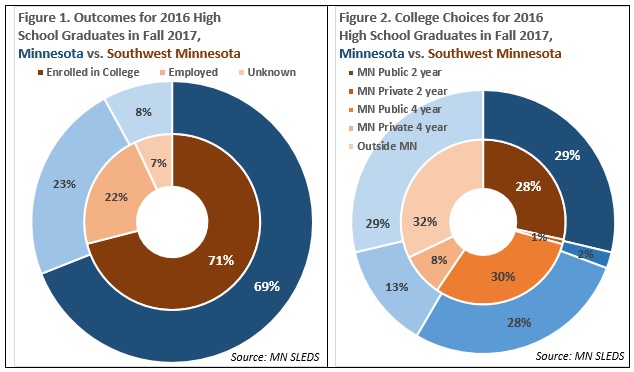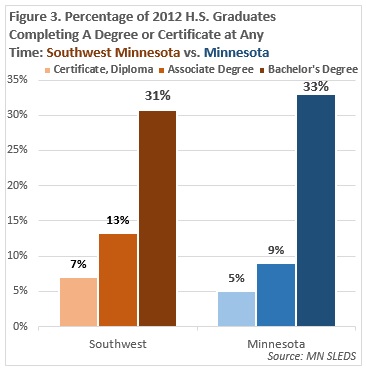 Southwest Minnesota is a national leader in agricultural production, and renewable energy.
Southwest Minnesota is a national leader in agricultural production, and renewable energy.
The region's thriving manufacturing sector includes food processing, machinery, printing, metal products, and computers and electronic products.
Want the freshest data delivered by email? Subscribe to our regional newsletters.
5/14/2018 10:09:32 AM
Luke Greiner
As the school year closes, thousands of high school graduates are preparing to walk across the stage to receive their diplomas. In 2016, more than 4,225 students graduated from high schools in the 23-county Southwest Minnesota planning region, ready to turn their educational and career dreams into reality.
Results from Minnesota's Statewide Longitudinal Education Data System (SLEDS) provide insight into what these students actually do upon graduation. In Southwest Minnesota, about 71 percent of last year's graduates enrolled in college in the fall, while 22 percent found jobs and started working. Results for the remaining 7 percent were unknown as the students may have moved outside the state, not joined the labor force, or became self-employed (Figure 1).
Graduates in Southwest Minnesota were slightly more likely to attend college than students across the state, and therefore slightly less likely to immediately join the workforce. Interestingly, the mix of colleges that Southwest graduates attended was also slightly different, with a higher percentage of local students attending public four-year state universities (30 percent vs. 28 percent) and 3 percent more attending college in other states (32 percent vs. 29 percent), primarily North Dakota, South Dakota, and Iowa (Figure 2).

Encouragingly, about 82 percent of Southwest Minnesota graduates who transitioned directly to college continued into their second academic year, which was 1 percent above the rate for students statewide. This persistence appears to pay off over time as well, with more students from the region eventually completing a degree or certificate. Looking back at the results for students from the 2012 graduating class (to give these students time to attend and complete college), Southwest Minnesota still outpaces the state in persistence and completion.
For the 2012 cohort, just over 50 percent of Southwest Minnesota graduates completed a degree or certificate by 2017, compared to 47 percent of graduates statewide. However, SLEDS data shows that students from Southwest were much more likely to have earned a certificate, diploma, or associate degree than other students in the state, but were less likely to have earned a bachelor's degree (Figure 3).

These students are perhaps responding to the educational requirements of employment opportunities in the region, which were more likely to require vocational training or an associate degree than jobs statewide. The region also had a lower percentage of current jobs requiring a bachelor's degree or higher, though there were high levels of demand for jobs across the entire educational spectrum, including for those who went straight to work from high school.
With all of these options available, SLEDS data can provide insight into what graduating seniors are doing to prepare for workforce success.
Contact Luke Greiner at 320-308-5378 or Mark Schultz.